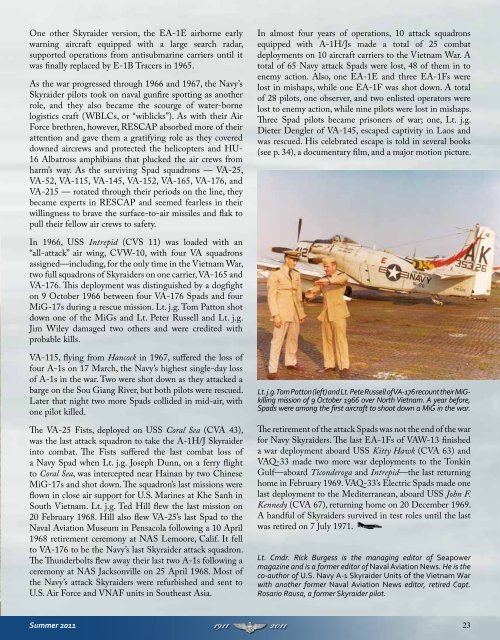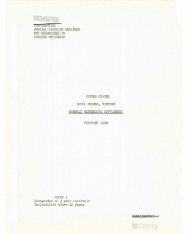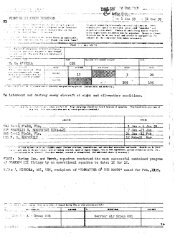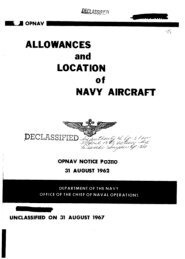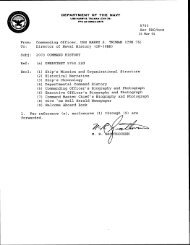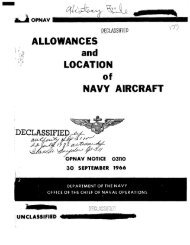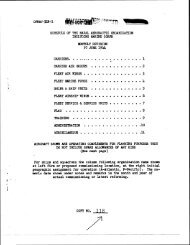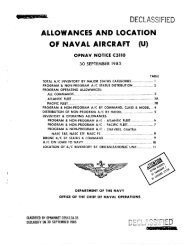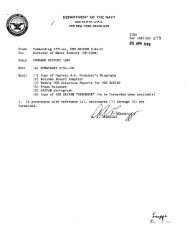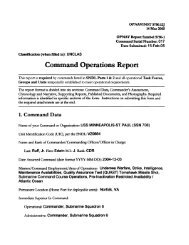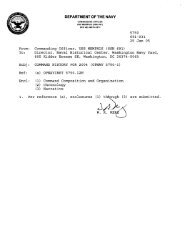“SPADS foreVer” - U.S. Navy
“SPADS foreVer” - U.S. Navy
“SPADS foreVer” - U.S. Navy
You also want an ePaper? Increase the reach of your titles
YUMPU automatically turns print PDFs into web optimized ePapers that Google loves.
One other Skyraider version, the EA-1E airborne early<br />
warning aircraft equipped with a large search radar,<br />
supported operations from antisubmarine carriers until it<br />
was finally replaced by E-1B Tracers in 1965.<br />
As the war progressed through 1966 and 1967, the <strong>Navy</strong>’s<br />
Skyraider pilots took on naval gunfire spotting as another<br />
role, and they also became the scourge of water-borne<br />
logistics craft (WBLCs, or “wiblicks”). As with their Air<br />
Force brethren, however, RESCAP absorbed more of their<br />
attention and gave them a gratifying role as they covered<br />
downed aircrews and protected the helicopters and HU-<br />
16 Albatross amphibians that plucked the air crews from<br />
harm’s way. As the surviving Spad squadrons — VA-25,<br />
VA-52, VA-115, VA-145, VA-152, VA-165, VA-176, and<br />
VA-215 — rotated through their periods on the line, they<br />
became experts in RESCAP and seemed fearless in their<br />
willingness to brave the surface-to-air missiles and flak to<br />
pull their fellow air crews to safety.<br />
In almost four years of operations, 10 attack squadrons<br />
equipped with A-1H/Js made a total of 25 combat<br />
deployments on 10 aircraft carriers to the Vietnam War. A<br />
total of 65 <strong>Navy</strong> attack Spads were lost, 48 of them in to<br />
enemy action. Also, one EA-1E and three EA-1Fs were<br />
lost in mishaps, while one EA-1F was shot down. A total<br />
of 28 pilots, one observer, and two enlisted operators were<br />
lost to enemy action, while nine pilots were lost in mishaps.<br />
Three Spad pilots became prisoners of war; one, Lt. j.g.<br />
Dieter Dengler of VA-145, escaped captivity in Laos and<br />
was rescued. His celebrated escape is told in several books<br />
(see p. 34), a documentary film, and a major motion picture.<br />
In 1966, USS Intrepid (CVS 11) was loaded with an<br />
“all-attack” air wing, CVW-10, with four VA squadrons<br />
assigned—including, for the only time in the Vietnam War,<br />
two full squadrons of Skyraiders on one carrier, VA-165 and<br />
VA-176. This deployment was distinguished by a dogfight<br />
on 9 October 1966 between four VA-176 Spads and four<br />
MiG-17s during a rescue mission. Lt. j.g. Tom Patton shot<br />
down one of the MiGs and Lt. Peter Russell and Lt. j.g.<br />
Jim Wiley damaged two others and were credited with<br />
probable kills.<br />
VA-115, flying from Hancock in 1967, suffered the loss of<br />
four A-1s on 17 March, the <strong>Navy</strong>’s highest single-day loss<br />
of A-1s in the war. Two were shot down as they attacked a<br />
barge on the Sou Giang River, but both pilots were rescued.<br />
Later that night two more Spads collided in mid-air, with<br />
one pilot killed.<br />
The VA-25 Fists, deployed on USS Coral Sea (CVA 43),<br />
was the last attack squadron to take the A-1H/J Skyraider<br />
into combat. The Fists suffered the last combat loss of<br />
a <strong>Navy</strong> Spad when Lt. j.g. Joseph Dunn, on a ferry flight<br />
to Coral Sea, was intercepted near Hainan by two Chinese<br />
MiG-17s and shot down. The squadron’s last missions were<br />
flown in close air support for U.S. Marines at Khe Sanh in<br />
South Vietnam. Lt. j.g. Ted Hill flew the last mission on<br />
20 February 1968. Hill also flew VA-25’s last Spad to the<br />
Naval Aviation Museum in Pensacola following a 10 April<br />
1968 retirement ceremony at NAS Lemoore, Calif. It fell<br />
to VA-176 to be the <strong>Navy</strong>’s last Skyraider attack squadron.<br />
The Thunderbolts flew away their last two A-1s following a<br />
ceremony at NAS Jacksonville on 25 April 1968. Most of<br />
the <strong>Navy</strong>’s attack Skyraiders were refurbished and sent to<br />
U.S. Air Force and VNAF units in Southeast Asia.<br />
Lt. j.g. Tom Patton (left) and Lt. Pete Russell of VA-176 recount their MiGkilling<br />
mission of 9 October 1966 over North Vietnam. A year before,<br />
Spads were among the first aircraft to shoot down a MiG in the war.<br />
The retirement of the attack Spads was not the end of the war<br />
for <strong>Navy</strong> Skyraiders. The last EA-1Fs of VAW-13 finished<br />
a war deployment aboard USS Kitty Hawk (CVA 63) and<br />
VAQ-33 made two more war deployments to the Tonkin<br />
Gulf—aboard Ticonderoga and Intrepid—the last returning<br />
home in February 1969. VAQ-33’s Electric Spads made one<br />
last deployment to the Mediterranean, aboard USS John F.<br />
Kennedy (CVA 67), returning home on 20 December 1969.<br />
A handful of Skyraiders survived in test roles until the last<br />
was retired on 7 July 1971.<br />
Lt. Cmdr. Rick Burgess is the managing editor of Seapower<br />
magazine and is a former editor of Naval Aviation News. He is the<br />
co-author of U.S. <strong>Navy</strong> A-1 Skyraider Units of the Vietnam War<br />
with another former Naval Aviation News editor, retired Capt.<br />
Rosario Rausa, a former Skyraider pilot.<br />
Summer 2011<br />
1911 2011 23


